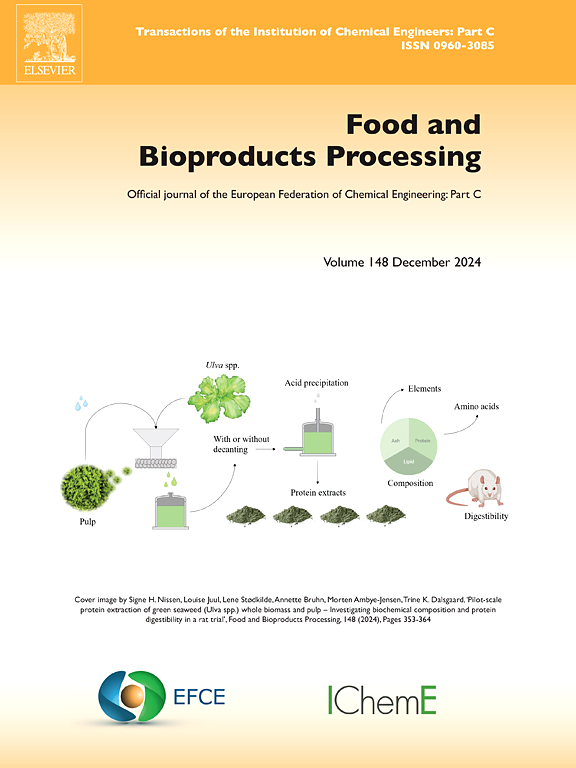Alkaline treatment for targeted lignin breakdown in rice straw: Maximizing phenolic content and product characterization
IF 3.5
2区 农林科学
Q2 BIOTECHNOLOGY & APPLIED MICROBIOLOGY
引用次数: 0
Abstract
Lignin is a significant renewable source for the production of phenolics and aromatic compounds for use as functional materials. Rice straw (RS), a lignocellulosic biomass was given alkaline treatment, to breakdown lignin into methoxyphenols and heterocyclic compounds, leaving behind carbohydrate rich residue. Process parameters such as NaOH (M), time (min) and liquid to solid (L:S) ratio (mL/g) were optimized using Response Surface Methodology (RSM) to enhance the extraction of phenolics. The maximum phenolic content (13.98 mg/g RS) was obtained after treatment with 3 M NaOH for 30 min with L: S ratio of 20:1 mL/g at 121°C. GC-MS revealed the presence of 14 compounds, primarily methoxyphenols like acetosyringone (32.44 %), 2-methoxy-4-vinyl phenol (23.71 %), vanillin (1.25 %) and 2, 6-dimethoxyphenol (1.49 %). Additionally, a significant proportion of a heterocyclic compound, 2, 3-dihydrobenzofuran (31.72 %), was also present. The extract exhibited considerable levels of 2, 2’-azino-bis (3-ethylbenzothiazoline-6-sulfonic acid) (ABTS) (IC50 (half-maximal inhibitory concentration) = 0.45 mg/mL) radical scavenging activity, which was comparable to ascorbic and gallic acids. With substantial conversion (60.17 %) of rice straw lignin to phenols and simultaneous recovery of both cellulose (45.7 %) and hemicellulose (14.6 %), this process can be useful in biorefining of lignocellulosic biomass to phenolic chemicals for application in food and pharmaceutical industry.
通过碱性处理定向分解稻草中的木质素:最大限度提高酚含量和产品特性
木质素是生产酚类和芳香族化合物的重要可再生资源,可用作功能材料。水稻秸秆(RS)是一种木质纤维素生物质,通过碱性处理可将木质素分解成甲氧基苯酚和杂环化合物,并留下富含碳水化合物的残留物。采用响应面法(RSM)对 NaOH(M)、时间(min)和液固比(L:S)(mL/g)等工艺参数进行了优化,以提高酚类物质的提取率。在 121°C 下,用 3 M NaOH 处理 30 分钟,液固比为 20:1 mL/g,酚含量(13.98 mg/g RS)最高。气相色谱-质谱(GC-MS)显示出 14 种化合物,主要是甲氧基酚类,如乙酰丁香酮(32.44 %)、2-甲氧基-4-乙烯基苯酚(23.71 %)、香兰素(1.25 %)和 2,6-二甲氧基苯酚(1.49 %)。此外,杂环化合物 2,3-二氢苯并呋喃(31.72%)的比例也很大。该提取物具有相当高的 2, 2'-azino-bis (3-ethylbenzothiazoline-6-sulfonic acid) (ABTS) (IC50(半最大抑制浓度)= 0.45 mg/mL)自由基清除活性,与抗坏血酸和没食子酸相当。该工艺可将大量稻草木质素(60.17%)转化为酚类,并同时回收纤维素(45.7%)和半纤维素(14.6%),因此可用于将木质纤维素生物质生物炼制成酚类化学品,应用于食品和制药行业。
本文章由计算机程序翻译,如有差异,请以英文原文为准。
求助全文
约1分钟内获得全文
求助全文
来源期刊

Food and Bioproducts Processing
工程技术-工程:化工
CiteScore
9.70
自引率
4.30%
发文量
115
审稿时长
24 days
期刊介绍:
Official Journal of the European Federation of Chemical Engineering:
Part C
FBP aims to be the principal international journal for publication of high quality, original papers in the branches of engineering and science dedicated to the safe processing of biological products. It is the only journal to exploit the synergy between biotechnology, bioprocessing and food engineering.
Papers showing how research results can be used in engineering design, and accounts of experimental or theoretical research work bringing new perspectives to established principles, highlighting unsolved problems or indicating directions for future research, are particularly welcome. Contributions that deal with new developments in equipment or processes and that can be given quantitative expression are encouraged. The journal is especially interested in papers that extend the boundaries of food and bioproducts processing.
The journal has a strong emphasis on the interface between engineering and food or bioproducts. Papers that are not likely to be published are those:
• Primarily concerned with food formulation
• That use experimental design techniques to obtain response surfaces but gain little insight from them
• That are empirical and ignore established mechanistic models, e.g., empirical drying curves
• That are primarily concerned about sensory evaluation and colour
• Concern the extraction, encapsulation and/or antioxidant activity of a specific biological material without providing insight that could be applied to a similar but different material,
• Containing only chemical analyses of biological materials.
 求助内容:
求助内容: 应助结果提醒方式:
应助结果提醒方式:


